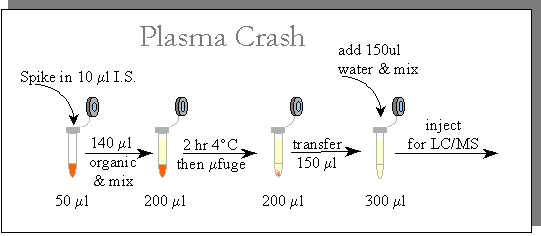|
|
Sample PreparationforPK//MS Analysis
|
Samples are usually supplied in plasma or
serum. Plasma is blood after the blood cells have been removed
usually by centrifugation. Serum is the fluid that is left after
blood has been clotted and the solids have been removed. Clotting
removes blood cells and clotting factors. Serum
is easier to
handle than plasma since the clotting factors have been removed.
When plasma is stored it is not uncommon to find fluffy clotted material
which makes the samples difficult (goopy) to pipette. Serum or
Plasma must then be prepared further before it can be loaded onto a
reverse phase column for analysis. There are a number of methods that can be
used to prepare plasma or serum for PK/MS analysis and several are
discussed below.
Plasma CrashPlasma crash is the method most commonly used since it does not generally require special instrumentation. With the plasma crash method acetonitrile or methanol is used to precipitate out the abundant serum proteins. A typical method is described below.
The Plasma Crash Method: 1.) Place 50 Áls of plasma or serum in a 0.5
ml tube.
Download the plasma crash method in MS Word
format Solid Phase ExtractionSolid phase extraction is preferred by many. In SPE, plasma or serum is added directly to a disposable hydrophobic solid support, usually a small C18 cartridge. After serum or plasma is added to the column organic solvent is passed through the column to elute the small molecule of interest. Solid phase extraction can be performed manually or with a small manifold. Performing this technique manually limits sample through-put. The technique is amenable to automation with solid phase supports available in 96 well formats. Some find the plate formats expensive with a single 96 well plate costing close to one hundred US dollars, however the cost should be balanced against ease of use and superiority of the final product. Some find that the final eluant for PK/LC/MS/MS analysis is superior in quality finding that reverse phase column fouling and roll-off of MS signal occurs at a slower rate.
Liquid-Liquid ExtractionAdmittedly we have little experience with this technique. Here is what we know. Liquid-Liquid extraction only works for those compounds that partition into the organic phase. It can be a very efficient method for sample clean up. However, the method is difficult to automate.
|
| Learn to Build a Standard Curve |
|
|
|
home
| disclaimer |
